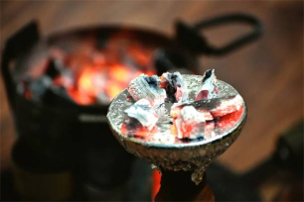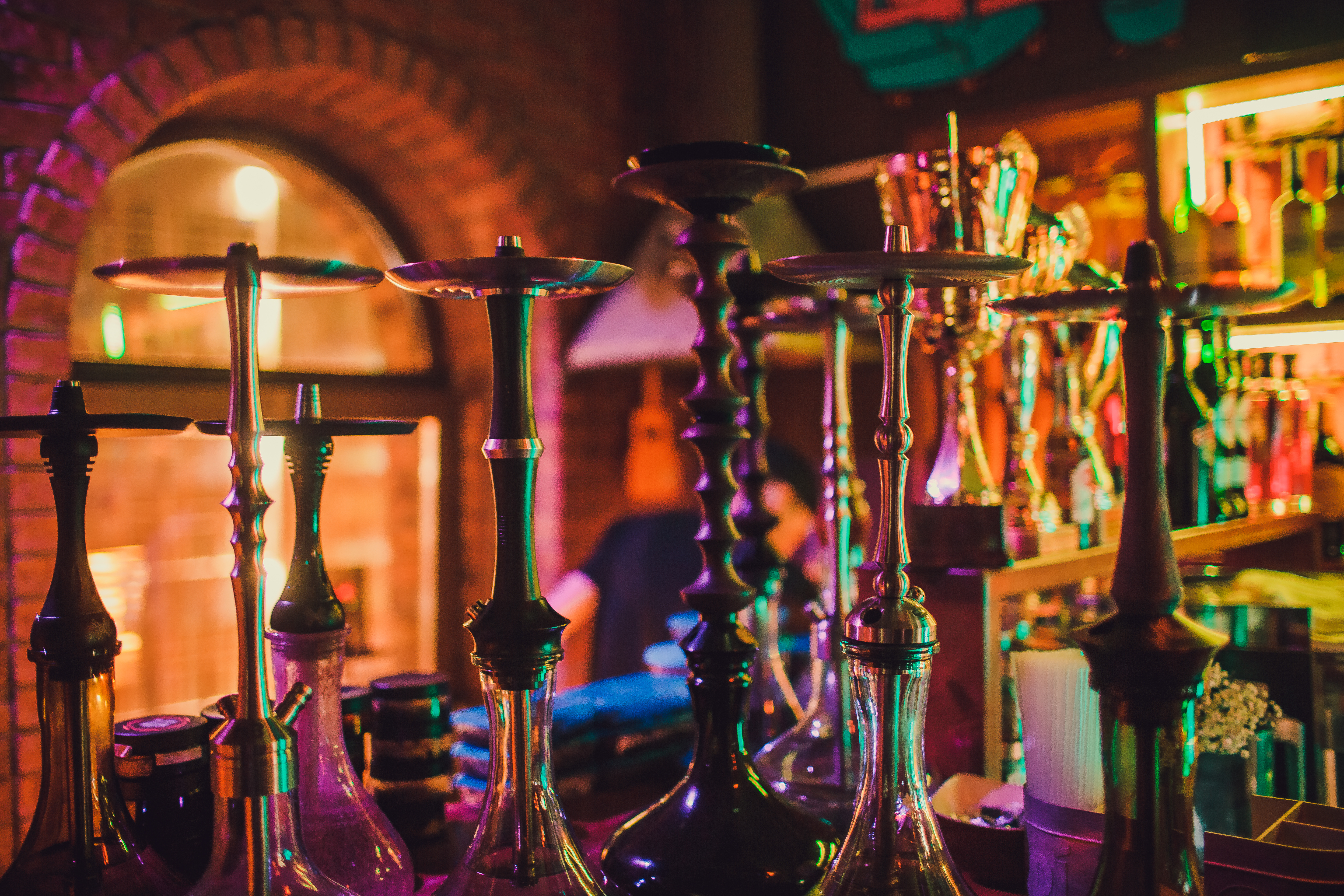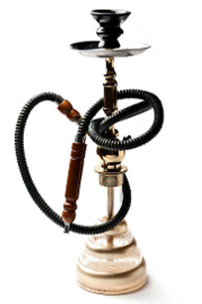Health Risks associated with Hookah Smoking

Compared to nonsmokers, hookah smokers have 2-3 times increase in respiratory disease (e.g., COPD), 4 times increase in oral cancer risk, 2 times increase in lung cancer, and 3 times increase in cardiovascular disease.6,7,8 Furthermore, the use of charcoal to heat the tobacco in the hookah results in additional exposures to high levels of carbon monoxide, metals, and cancer-causing chemicals.9,10,11 Smoking in a group setting and sharing the same hookah can furthermore, expose users to communicable diseases risks (e.g., tuberculosis, herpes).12,13 Hookah smoking also releases secondhand smoke, which can be a health risk particularly to children living in hookah smoking homes.14
Communicating hookah-associated risks through health warning labels promises to reduce hookah smoking and hookah-related morbidity and mortality in Florida and nationally. In the health warning labels Delphi study conducted by Dr. Asfar and colleagues, five major themes were identified for the negative effects of hookah smoking. Health risks associated with hookah smoking, addiction, harm to others, hookah-specific harm, and hookah smoking harm compared with cigarettes.
- Health risks associated with waterpipe smoking
Evidence suggests a significant association of hookah smoking with lung and oral cancer and a significant association with cardiovascular disease, respiratory diseases, candida and skin disease, and periodontal disease.15,8
- Addiction
Hookah smoking delivers the same highly addicting drug that is found in other tobacco products, nicotine.16
- Harm to others
Children living in homes with hookah smoker home experience a significantly higher intake of nicotine and carcinogens than children living in nonsmoker homes.17 Babies born to hookah smokers are not only born weighing less than babies born to non-smokers but are at an increased risk for respiratory diseases.18,19
- Hookah-specific harm
A number of health risks arise from the charcoal utilized to heat the tobacco by producing high levels of carbon monoxide, metal, and cancer-causing chemicals even after the smoke has passed through the hookah.13 Evidence from systematic reviews shows that hookah smoking is associated with increased risk of lung cancer, and major cardio-pulmonary diseases.6,7,8 Moreover, unique risks of hookah smoking can stem from the contribution of charcoal (e.g. carcinogens), device and accessories (e.g. infectious disease).13
- Hookah smoking harm compared to cigarettes
The amount of smoke inhaled during a hookah session is significantly higher than when smoking a cigarette. The increase in carbon monoxide levels is much higher in waterpipe smoking than in cigarette smoking.20 A one-hour long hookah smoking session involves 200 puffs as opposed to 10-13 puffs from a single cigarette session.21 Compared to one cigarette, a single hookah session involves exposure to 150-180 times the amount of smoke (≈90,000 ml of smoke for hookah vs. 500-600 ml for cigarettes), 1.7 times the nicotine, 8.4 times the CO, and 36 times the tar.22
References
- Pratiti R, Mukherjee D. Epidemiology and Adverse Consequences of Hookah/Waterpipe Use: A Systematic Review. Cardiovasc Hematol Agents Med Chem. 2019;17(2):82-93. doi: 10.2174/1871525717666190904151856. PMID: 31483237.
- Salloum RG, Thrasher JF, Getz KR, Barnett TE, Asfar T, Maziak W. Patterns of waterpipe tobacco smoking among US young adults, 2013− 2014. American journal of preventive medicine. 2017;52(4):507-512.
- Wang TW, Gentzke A, Sharapova S, Cullen KA, Ambrose BK, Jamal A. Tobacco product use among middle and high school students—United States, 2011–2017. Morbidity and Mortality Weekly Report. 2018;67(22):629.
- Florida Department of Health (2018). "Tobacco Use in Florida Youth Ages 11-17: 2012 - 2017." from http://www.floridahealth.gov/statistics-and-data/survey-data/florida-youth-survey/florida-youth-tobacco-survey/_documents/FYTS%20State%20Tables%202012-2017%20final.pdf
- Florida Department of Health (2020). "Tobacco Use in Florida Youth Ages 11-17: 2014 - 2020." http://www.floridahealth.gov/statistics-and-data/survey-data/florida-youth-survey/florida-youth-tobacco-survey/FYTS2020StateLevelReport.pdf
- Jawad, M., et al. (2013). "To what extent should waterpipe tobacco smoking become a public health priority?" Addiction 108(11): 1873-1884.
- El-Zaatari, Z. M., et al. (2015). "Health effects associated with waterpipe smoking." Tobacco control: tobaccocontrol-2014-051908.
- Waziry R, Jawad M, Ballout RA, et al. The effects of waterpipe tobacco smoking on health outcomes: an updated systematic review and meta-analysis. Int J Epidemiol 2017;46:32–43.
- Monzer, B., et al. (2008). "Charcoal emissions as a source of CO and carcinogenic PAH in mainstream narghile waterpipe smoke." Food and Chemical Toxicology 46(9): 2991-2995.
- Nguyen, T., et al. (2013). "Charcoal burning as a source of polyaromatic hydrocarbons in waterpipe smoking." Journal of Environmental Science and Health, Part B 48(12): 1097-1102.
- Center for Diseases Prevention and Control (CDC). Smoking and Tobacco Use. Hookahs. https://www.cdc.gov/tobacco/data_statistics/fact_sheets/tobacco_industry/ hookahs/
- Martin, J. (2009) Booming hookah biz links China, Iran, Egypt - and Texas CNNMoney
- Center for Diseases Prevention and Control (2018). Hookahs. https://www.cdc.gov/tobacco/data_statistics/fact_sheets/tobacco_industry/hookahs/index.htm
- Fromme, H., et al. (2009). "Indoor air contamination during a waterpipe (narghile) smoking session." Food and Chemical Toxicology 47(7): 1636-1641.
- Awan KH, Siddiqi K, Patil S, et al. Assessing the effect of waterpipe smoking on cancer outcome - a systematic review of current evidence. Asian Pac J Cancer Prev 2017;18:495.
- Aboaziza E, Eissenberg T. Waterpipe tobacco smoking: what is the evidence that it supports nicotine/tobacco dependence? Tob Control 2015;24(Suppl 1):i44–i53.
- Kassem NO, Daffa RM, Liles S, et al. Children’s exposure to secondhand and thirdhand smoke carcinogens and toxicants in homes of hookah smokers. Nicotine Tob Res 2014;16:961–75.
- Tamim H, Yunis KA, Chemaitelly H, et al. Effect of narghile and cigarette smoking on newborn birthweight. BJOG 2008;115:91–7.
- Nuwayhid IA, Yamout B, Azar G, et al. Narghile (hubble-bubble) smoking, low birth weight, and other pregnancy outcomes. Am J Epidemiol 1998;148:375–83.
- Jacob P, Abu Raddaha AH, Dempsey D, et al. Nicotine, carbon monoxide, and carcinogen exposure after a single use of a water pipe. Cancer Epidemiol Biomarkers Prev 2011;20:2345–53.
- Cobb C, Ward KD, Maziak W, et al. Waterpipe tobacco smoking: an emerging health crisis in the United States. Am J Health Behav 2010;34:275–85.
- Cobb CO, Shihadeh A, Weaver MF, Eissenberg T. Waterpipe tobacco smoking and cigarette smoking: a direct comparison of toxicant exposure and subjective effects. Nicotine Tob Res. 2011 Feb;13(2):78-87. doi: 10.1093/ntr/ntq212. Epub 2010 Dec 2. PMID: 21127030; PMCID: PMC3107609.






